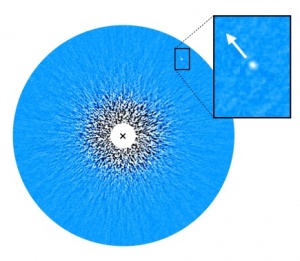 An article published in “The Astronomical Journal” offers an explanation of the formation mechanisms of gas giant planets and brown dwarfs bringing evidence that these are two different mechanisms. A team of astronomers led by Brendan Bowler of the University of Texas, Austin, conducted observations at the Keck Observatory and with the Subaru Telescope, both in Hawaii, accompanied by computer simulations using the free / open source orbitize! software to try to understand if there were orbital differences that indicated a different origin between these objects. Their conclusion is that brown dwarfs have significantly more elliptical orbits.
An article published in “The Astronomical Journal” offers an explanation of the formation mechanisms of gas giant planets and brown dwarfs bringing evidence that these are two different mechanisms. A team of astronomers led by Brendan Bowler of the University of Texas, Austin, conducted observations at the Keck Observatory and with the Subaru Telescope, both in Hawaii, accompanied by computer simulations using the free / open source orbitize! software to try to understand if there were orbital differences that indicated a different origin between these objects. Their conclusion is that brown dwarfs have significantly more elliptical orbits.
Brown dwarfs are objects halfway between planets and stars, with masses between 13 and 75 times that of Jupiter. However, these are definitions based on empirical data because their existence was discovered only in the 1990s and astronomers are still trying to fully understand them. Studies that aimed to understand the brown dwarfs’ formation mechanisms have already been carried out in the past but technological improvements today allow direct observations of these substellar objects and gas giant planets. At the same time, the enormous growth in computer power allows more accurate simulations that are performed much faster.
Dr. Brendan Bowler’s team carried out observations using the Near-Infrared Camera, second generation (NIRC2) instrument on the Keck II telescope and the Subaru telescope to capture direct images of giant planets and brown dwarfs in 27 systems. These objects orbit at considerable distances from their stars, therefore their year can last even Earth’s centuries. This means that it’s impossible to observe their complete orbits but even observing a sufficient fraction to extrapolate the rest is a long task. As a result, the researchers combined a series of new observations with all the data available from research conducted in previous years.
The top image (Courtesy Brendan Bowler (UT-Austin)/W. M. Keck Observatory. All rights reserved) shows the binary system containing the brown dwarf GJ 504 B, shown in the magnified inset at the top, photographed with the Keck II telescope’s NIRC2 instrument.
The result is still far from complete so computer simulations have been added. Some of the authors of this research contributed to the development of orbitize!, a free / open source software released under a BSD 3-Clause license that uses Kepler’s laws of planetary motion to identify which orbits are consistent with the positions measured and which are not.
Thanks to the data collected, orbitize! generated a series of possible orbits for each gas giant planet and brown dwarf part of this study. The bottom image (Courtesy Brendan Bowler (UT-Austin). All rights reserved) shows the orbits reconstructed using the program orbitize! of 9 of the 27 objects studied.
The greater the amount of data available, the more refined the shape of the orbit, leaving fewer unknown parts. In particular, the researchers were interested in the shapes of the various orbits to understand if there were significant differences between those of gas giant planets and those of brown dwarfs. The result is a significant difference in the eccentricity of their orbits with planets that have significantly more circular orbits than brown dwarfs.
The researchers concluded that the different orbital characteristics of planets and brown dwarfs are due to different formation mechanisms: the planets formed from a protoplanetary disk of gas and dust that surrounded their stars while brown dwarfs formed following the fragmentation of a cloud from which one part led to the formation of the star and the other part to the formation of the brown dwarf.
Brendan Bowler pointed out that the sample is modest at the moment and the research will continue also trying to expand it. His team will keep on monitoring the 27 objects studied to increase the accuracy of their orbits’ reconstruction and is examining data collected by ESA’s Gaia space probe in search of other candidates to study. In the coming years it will be possible to conduct direct observations with new instruments such as the Giant Magellan Telescope (GMT) to obtain more step forward.


